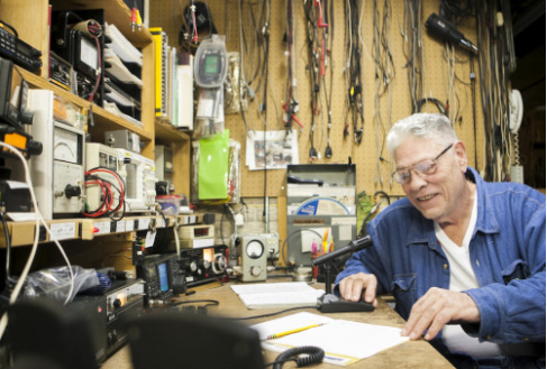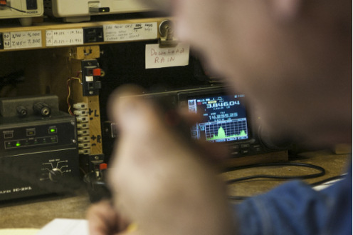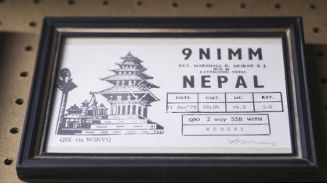Local amateur radio operators reach out to world
Published: Wednesday, Jan. 21, 2015 5:26 p.m. CST
By ADAM POULISSE – apoulisse @shawmedia.com
Mike Heiderscheidt was sitting in the basement of his Waterman home Monday night, but the world was
at his fingertips.
Machines beeped and squawked to life all around the 74-year-old. With a hand-held microphone – similar
to the ones used by truck drivers – Heiderscheidt did roll call for a list of amateur radio users and call
letters from as far as Cedar Rapids, Iowa. Amateur radio users squawked back, checking their signal
strength and reception, a weekly practice called "opening the net."
On Monday, 26 HAM radio operators responded loud and clear (most of the time) to Heiderscheidt's roll
call.
"This is a good night," Heiderscheidt said. "Usually only 15 to 20 people check in because they're doing
something else. But this is a good test. In an emergency, we know we're able to communicate with each
other."
A syndicated weather report ran for nine minutes, before Heiderscheidt got back on air to announce his
amateur radio station's call letters – WD9GNX. Amateur radio stations can only broadcast for 10 minutes
before they have to ID themselves on air again, Heiderscheidt said.
Welcome to Heiderscheidt's HAM radio section of his basement – his "ham shack," as he calls it.
"It's a hobby, it's fun," said Heiderscheidt, who received his amateur radio license in 1977.
HAM radio, or amateur radio, might seem primitive compared with today's technology such as podcasts
and cell phones, but it's a hobby still enjoyed by many, primarily older, residents, and local enthusiasts
say their number has grown.
There are 236 amateur radio operators in DeKalb County, but some of the licenses have recently expired,
according to Bob Yurs, President of
Kishwaukee Amateur Radio Club
, which has 40 members, mostly
older residents from DeKalb County. The youngest member is Yurs' 18-year-old grandson.
Club meetings are held the second Wednesday of each month at 7 p.m. at Community of Christ Church in
DeKalb, 1200 S. Malta Drive.
"For a while, membership didn't grow a lot," Yurs said. "Over the last few years, we've increased by
several new people. I got to admit, the HAM radio has been taken away from the younger generation,
because of all the cell phone technology and laptops and Skype."
The club maintains a 2-meter repeater in Malta that helps boost local amateur radio stations' signals. It is
running full-power at 250 watts, allowing the signal to go across the world. The U.S. is divided into nine
amateur radio sections. DeKalb County is in "eight land," Heiderscheidt said.
1 of 4
ChronicleArticle_012115\Chronicle_HAM_Radio_012119.doc
Danielle Guerra - dguerra@shawmedia.com Ham Mike Heiderscheidt, WD9GNX call sign, performs an on-air net
test for other amateur HAM radio operators from his Waterman basement on Monday, January 19, 2015.
Heiderscheidt conducts the test every Monday night at 9 p.m. to call role and play the weekly rain report on-air for
other hams to check their signal strength.
An FCC-mandated test is required to obtain an amateur radio license, and content is also
monitored by the FCC. Kishwaukee Amateur Radio Club proctors the exam every third Saturday
of every odd-numbered month at Community Church of Christ. A study guide consisting of
possible questions is available online.
Much to Yurs' content, the licensing test no longer requires knowledge of Morse code, the
communication system popularized during the telegraph era and used until the 1990s in the
shipping industry and by seafaring vessels.
HAM radio's name is an acronym of
the last names of radio pioneers
Howard Hertz, Edwin Howard
Armstrong and Gugliemo Marconi.
Operators communicate on a range of
topics, everything from simple chit-
chat to severe weather updates.
"We keep talks of politics to a
minimum, and we don't really talk
about religion," Heiderscheidt said.
2 of 4
ChronicleArticle_012115\Chronicle_HAM_Radio_012119.doc


Members of the Kishwaukee radio club assist on local events such as March of Dimes and the
Sycamore Pumpkin Festival parade to ensure the event runs smoothly.
"If you can't see anybody, you can't communicate with them," said Barry Leonard, whose call
letters are W9JBL. "We are in a position to use our radios to assist the organizers in these things
to let the organizers know how the ride is progressing. We have our people spotted along the
route each year."
Amateur radio should not be confused with CB (citizens band) radio, which is more for short-
distance purposes. The FCC stopped licensing CB radios in the 1980s. Heiderscheidt and Yurs
both said they stopped participating in CB radio after conversations became too vulgar.
But amateur radio also grows communities, locally and globally. Long-distance connections are
possible because the amateur radio waves easily bounce long distances between the ground and
the earth's ionosphere, said Tom Ciciora, Illinois Section Manager for the American Radio Relay
League.
"It's like bouncing a ball," Ciciora said. "If the gods are with you, you might be able to make a
direct path to someone on the other side of the world."
Bill Vickers, 60 of Sycamore, has communicated with people in about 320 countries since
obtaining his license in 1969. That's more countries than there are in the world, but HAM radio
considers large islands to be their own countries.
HAMs who use their radios to connect with others in far-away lands are known as DXers.
Vickers has a laundry list of countries he's touched base with: Saudi Arabia, Egypt, Kazakhstan,
Russia, Siberia, India and Pakistan. However, he's most proud of making rare contact with
someone with a "very, very powerful station" in Kuwait a couple of times over the years.
"We often talk about our radios, and we talk about the particular radio station at the time," said
Vickers, KN9N on the amateur radio frequency. "Occasionally we talk about our families. It
really depends on the moment and how much time we have to speak."
Heiderscheidt has a postcard displayed in his work space from when he first made contact with a
HAM in Nepal, often thought to be the only HAM radio operator there.
With the older generation more interested in
their ham radios, and younger generations
doing the exact same thing with their cell
phones, the future of ham radio is uncertain,
Heiderscheidt said.
"We are finding as hams are getting older,
not as many younger people are getting into
it," he said.
3 of 4
ChronicleArticle_012115\Chronicle_HAM_Radio_012119.doc

However, unlike cell-phone and internet-enabled communication, HAM radio allows users to be
much more self-reliant, Vickers said.
"We make our own infrastructure," he said. "We don't rely on networks or cell towers or
Comcast. We rely on ourselves to set up the communication circuit. If a cell tower goes down, it
doesn't matter to us. We can go in there and we're up and running as quick as we can."
4 of 4
ChronicleArticle_012115\Chronicle_HAM_Radio_012119.doc